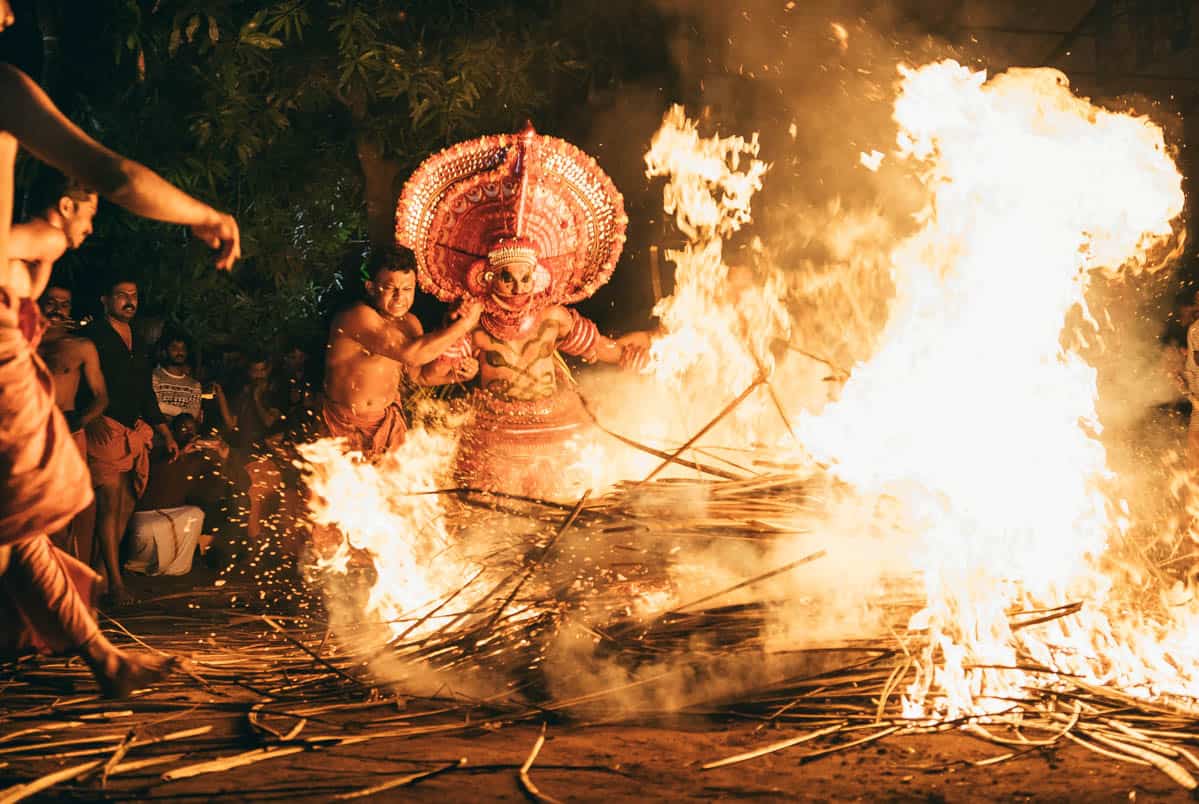
I crouched down in front of a giant roaring fire about 4 am, camera in hand. The heat on my face and body was like nothing I had ever experienced. “Why am I so close?” I kept asking myself.
Before I knew it, there was a huge glow and the heat intensified alarmingly fast like a punch in the face. As a result, my eyeballs strained from the heat. I quickly glanced up into the air to notice large, burning red embers dancing in the sky. They hung there for a second before raining down on me, scorching my bare feet and exposed skin.
The hot ash seared through the thin shirt on my back and a man standing behind me hastily brushed the flaming debris off me. Still crouched we held our positions, eyes locked onto the magnificent performance that was before us. Certainly, I had never seen anything like it.
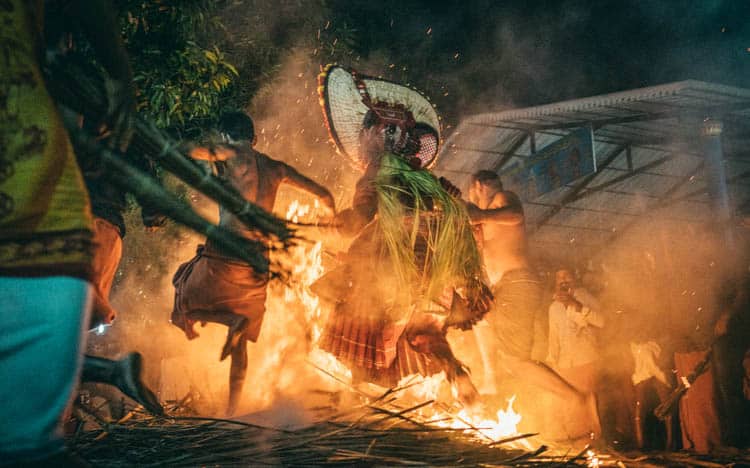
Journey to Pazhayangadi
I’d been shaken awake in my bed the previous morning. The train I was on creaked and wound through the hazy tree-lined fields that were Northern Kerala. I scrambled my 6’ 2” frame out of the tiny middle bunk, grabbed my bag and headed for the door.
The humid air rushing through the open carriage door was a nice wake-up call. As the train came to a slow stop at the next station I jumped off. I was in the town of Pazhayangadi. I had been travelling in India for a couple of weeks now and was heading south into Kerala to hopefully catch a glimpse of a fire Theyyam ceremony.
Theyyam is a ritualistic folk dance of Kerala dating back around 1500 years. It is performed across Kunnar and the neighbouring districts in Northern Kerala. The performances take place from October to May and the ceremonies are becoming popular tourist attractions in Kerala.
Having travelled through Goa on my way south, I had grown tired of sitting on a beach, witnessing the overtourism on the shack-lined beaches. I had become all too used to hearing the chit-chat of Westerners and loved-up honeymooners. Perhaps guilty of looking down on them, I was craving something more authentic.
After watching the train clatter off into the morning sun, I headed out of the station to explore the small town. The town was very much off the tourist trail. As I strolled down the roads, it was nice to exchange waves and smiles with the friendly locals.
After sharing stories with one local guy, he kindly offered me a lift to my homestay. After a white-knuckle ride through the rural landscape, one hand clinging onto the back of his motorbike and one hand on Google Maps, we reached my destination.
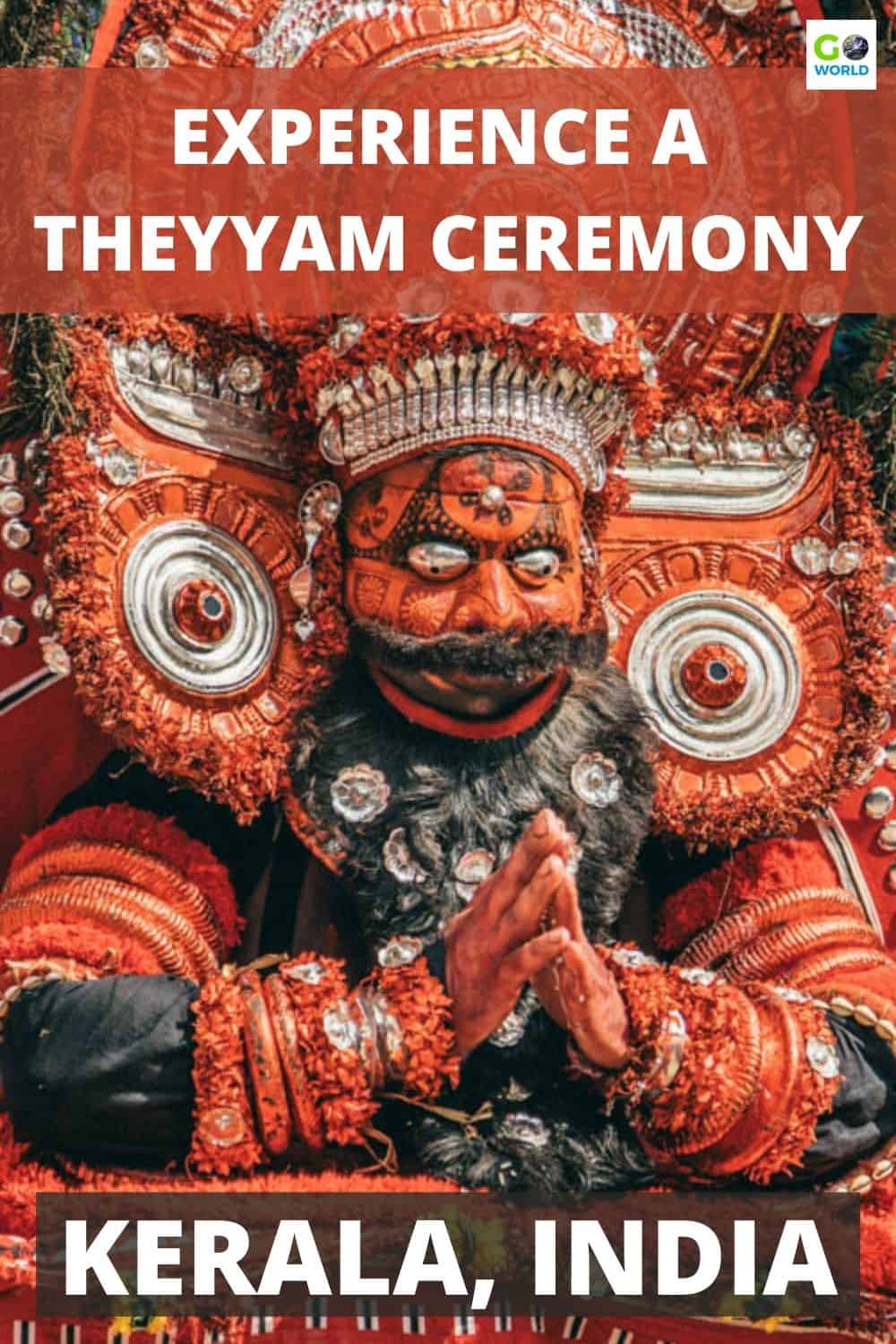
A Plan to Witness a Theyyam Ceremony
Due to the locality of each ceremony, it was a bit difficult researching where I could catch a fire Theyyam performance. Ceremonies are usually performed in family-owned places of worship. Or the grounds of local influential families where the task of performing is handed down through generations.
The ritual is usually performed to provide the safety and well-being of the local families and community. Therefore, the local villages feel it is their duty to please the gods and spirits with an act of worship.
There are over 1000 performances during the Theyyam season so it can be a bit daunting. After much debating, I hired a local expert named Santosh who I would be staying with. It seemed that Santosh knew everything there was to know about Theyyam and other South Indian ritual ceremonies. His family home was decorated with Theyyam artworks of varying forms, spiking my interest in what lay ahead.
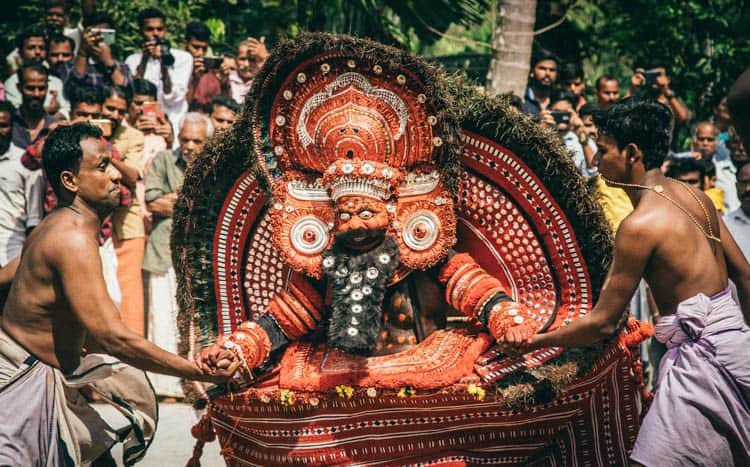
The First Theyyam Encounter
After about an hour’s drive and a few pit-stops to ask locals for directions, we left the vehicle and embarked down a hill towards a large crowd of locals gathered inside the temple grounds. As I crouched down on the edge of the space the anticipation was building. A group of men with drums stood in the middle of the crowd and began to steadily beat the drums.
As the tempo grew faster, loud chanting erupted from the group. Songs about the godly characteristics of the Theyyam are played beforehand creating a sense of mystery and anticipation of what was about to happen. Local villagers stood around dressed in traditional wear.
Young men and children were sat near the front with smartphones at the ready, creating an odd contrast between an ancient 1500-year-old ritual ceremony and modern technology. This is something inherently common throughout India and is part of its charm.
As the drums and percussion reached a dizzying tempo, the energy in the crowd was rising. Two characters painted from head to toe in red, with elaborate headpieces and carrying huge swords entered the performance space. The costumes were more impressive in person than I had expected.
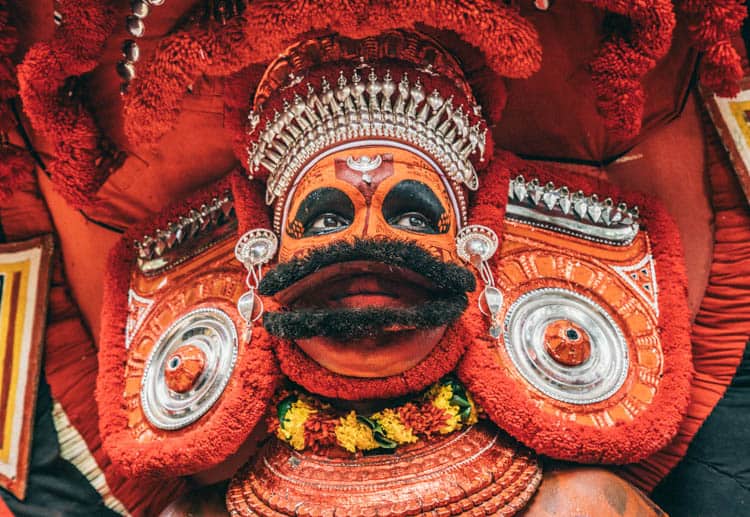
Detailed Decoration
The decoration was extremely detailed. Each Theyyam was adorned in decorative bangles and varying ornaments that complimented the characteristics of the performer. The bold contrast between the red body paint and the black trim of the headpieces was striking. It was obvious just how many painstaking hours go into creating costumes and make-up of this level.
The performers were Urpazhassi Theyyam and Vettakkorumakan Theyyam. They began performing a ritual dance together, marching around the edge of the space waving their swords. The metal bangles around their ankles rang out with every step and the metal ornaments on their costumes clashed as they continued to march to the beating drums.
The dancing varies with each performer. Legend says the spirit from the God or Goddess enters the body of the performer in an almost possessed like nature. Therefore becoming God – again with varying degrees of intensity for each character.
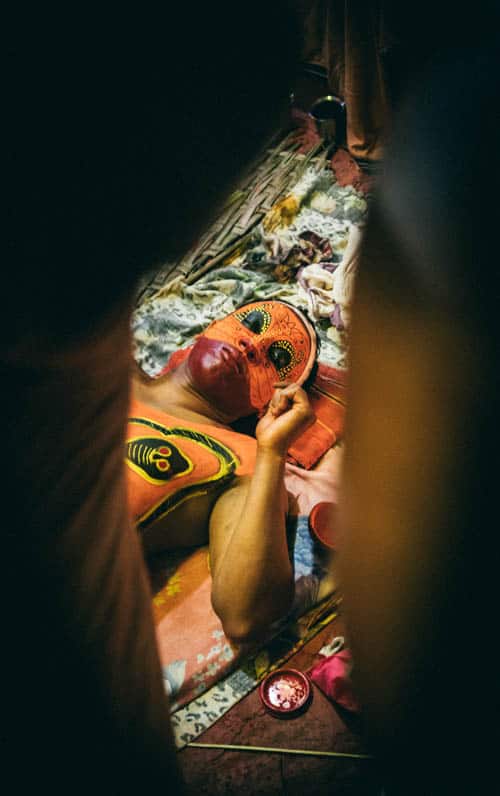
Unease of Being the Outsider
As the Theyyams passed, I locked eyes with one for the first time. I noticed the detail in his face close up as he stood in front of me. The whites of his eyes appeared so bright in contrast to the black make-up.
I was in awe of the presence they had. But I also felt slightly unnerved being so obviously foreign in the crowd of locals. I wondered what he thought of a western tourist attending such a grounding ritual.
Were they proud to share such an ancient tradition with outsiders like me? Were they worried that eventually, these rituals would become no more than a photo opportunity for tourists? Do the locals fear the popularisation of sacred rituals to tourists as a ‘marketable experience’?
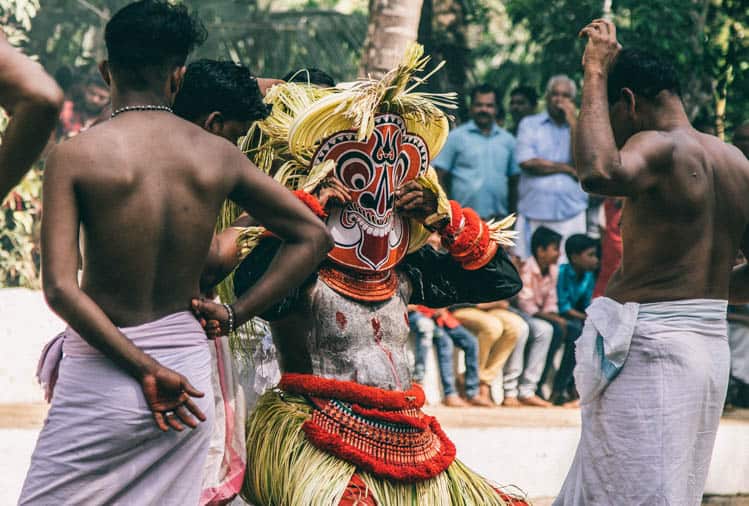
Emotions Run High
I saw one woman crying which made me realise how devoted the locals were to the Theyyams. How they felt the presence of God was in front of their very eyes. It created an entirely different connection to my admiration of the performance.
As the afternoon rolled on, the hour-long performance was followed by two other types of performances. These were the Karimkuttychattan Theyyam and Gulikan Theyyam. This time the energy and tempo felt a lot higher.
I got to witness the performers having their masks fixed into place as they slowly embodied the gods. Then they were running through and into the spectators. It was a little frightening as the masked men frantically crashed into people in a possessed nature.
One Theyyam was waving a burning torch side to side as he ran around. When the torch suddenly scorched my arm, it set the tone for what was to happen later that evening.
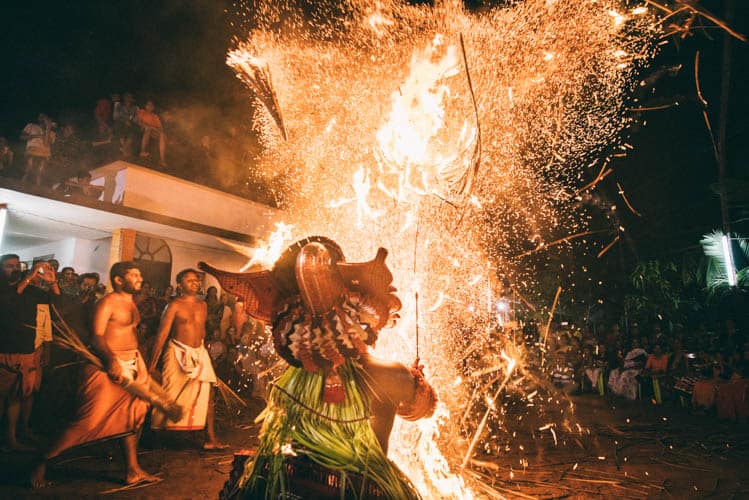
Into the Night
With only a few hours in-between to charge my camera batteries, we were heading down a single dirt track road at nightfall to catch two more Theyyam performances. This time, the fire would be the centrepiece, enhancing the spectacle to a whole new level.
We arrived outside the temple. The fluorescent strip lights that were fixed to the building and the surrounding palm trees omitted a blue hue into the thick warm air. I arrived to see the headless body of a sacrificed chicken lying next to an elderly women on rows of plastic chairs. Also, groups of men were bundling dry palm leaves to construct the fire.
Behind a gathering of people preparing for the next ceremony, I noticed a couple of the performers lying on the floor having their face and body make-up applied. I edged closer to catch a glimpse of the transformation – the precision and detail were remarkable.
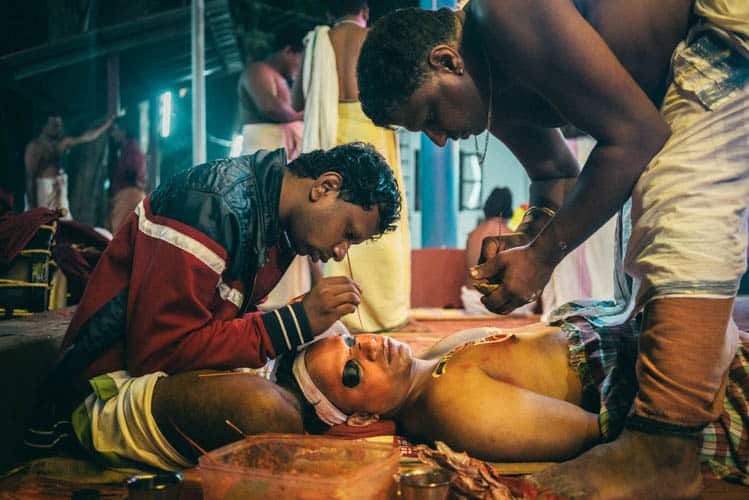
Transformation
The performers were lying deadly still as the small and delicate brushstrokes were applied to their skin. Their eyes peered up at the sky, patiently waiting. The bright-coloured paints used by the Theyyam teams were once naturally made. But in modern times, more synthetic make-up has been used as the demand for performances increased. This was the only sneak-peak allowed. Changing into costume and into full transformation took place in the relative privacy of a palm cubicle.
I could feel the energy in and around the temple building by the minute. By now a circle of spectators was forming in the dusty temple courtyard, people had climbed onto the temple roof eager to get the best view and the bundles of palms were being piled up in the middle of the space.
Suddenly, the familiar beat of drumming filled the air, followed by the crashing of percussion instruments. The tempo was rising and the crowds thickened. A few men with burning torches lit the bonfire. I immediately knew that we were all probably a little too close. As the fire was lit, my body was overcome with heat. But at the same time I was frozen in place with anticipation.
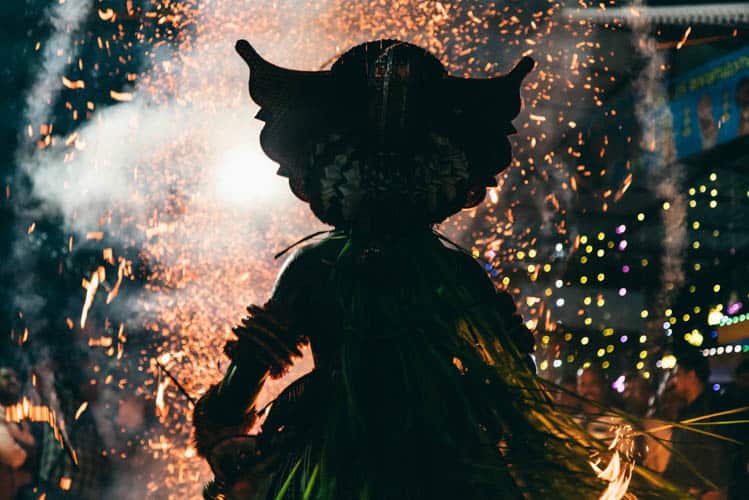
Kandanar Kelan Vellattam Theyyam
From the other side of the temple, with an entourage of percussionists, the great Kandanar Kelan Vellattam appeared. From what I could tell, he had already embodied the spirit of the gods. He was dancing and spinning around the fire furiously and the drums were at full speed to match his energy.
The spectators and I crouched at the front snapped away on our cameras. Suddenly, the Theyyam and a handful of his procession prodded the roaring fire using large wooden sticks. With great strength, they threw the embers and palm leaves straight up into the air. The air glowed red and the heat intensified.
As my face burned from the heat, my eyes filled with astonishment. Then, from the sky above, the red-hot embers came raining down on all of us crouched at the front. Some people scrambled back, others just brushed it off and welcomed the few small burns. I fell into the latter group, not wanting to take my eyes off the performance.
The Theyyams aides piled up the burning debris onto the fire and threw on more bundles of dry palms. After more frenzied rituals and dancing, the fire was again lifted into the air with the same force as before. This continued throughout the hour or so long performance.
As the intensity and fire dulled, the Theyyam made his way around the spectators, still manifesting the spirit of the God. He gave them his blessing in return for humble donations. Despite its popularity and high risk, performing Theyyam isn’t a profitable income. It is highly seasonal with performers working for only 5-6 months a year. They sustain themselves throughout the year with an average of RS 800 ($10) for a performance, plus donations from the audience.
Sweating and covered in ash, I made my way back from the front row, trying not to stand barefoot on any of the leftover embers. My skin cooled as I sat back on a concrete wall to digest the performance.
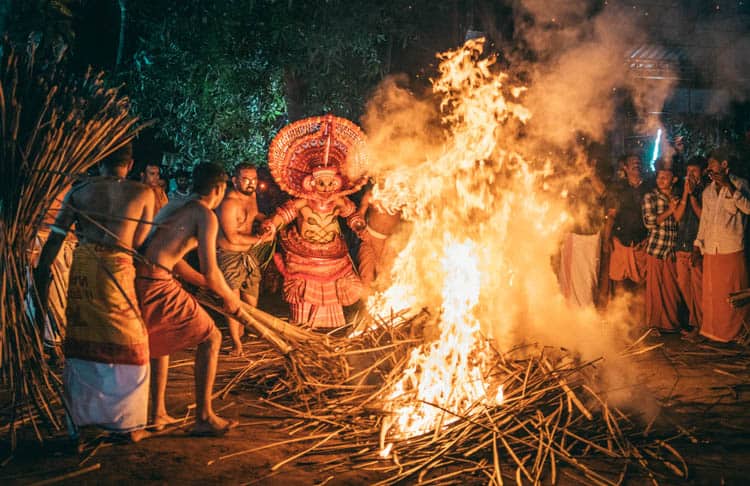
The Last Dance
Drums and chanting bellowed from the other side of the temple as 4 am approached. The possessed Theyyam entered with men holding his arms back to control his frenzy and they marched around the fire now burning furiously.
Suddenly, the Theyyam broke free from their grip. With only his bare feet, he ran straight towards the fire and disappeared into it, reappearing on the other side. The bundled palms would have been harsh enough on the soles of the feet, I thought, but walking over them on fire was hard to imagine.
With the fire obscuring my view and the drumming almost deafening, I could hardly make out his form heading back towards me. Suddenly the Theyyam once again burst through the fire, running over the burning fuel with every step. After each pass through the fire, the Theyyam’s aides would sweep the debris back onto the fire and feed it more palms.
All the while, the elaborate costume miraculously did not catch fire as he continued to run. The heat and smell of the burning fire in the night sky, the huge red costume, the loud drumming and chanting created a sensory overload.
The Theyyam’s aides were holding his arms back yet again as he thrashed around in an enthralling nature. Then, all three of the men ran towards the fire and through it. Consequently, the aides were engulfed in the fire, bare feet and skin exposed. Without hesitation, they would turn around and run straight back through the burning fire.
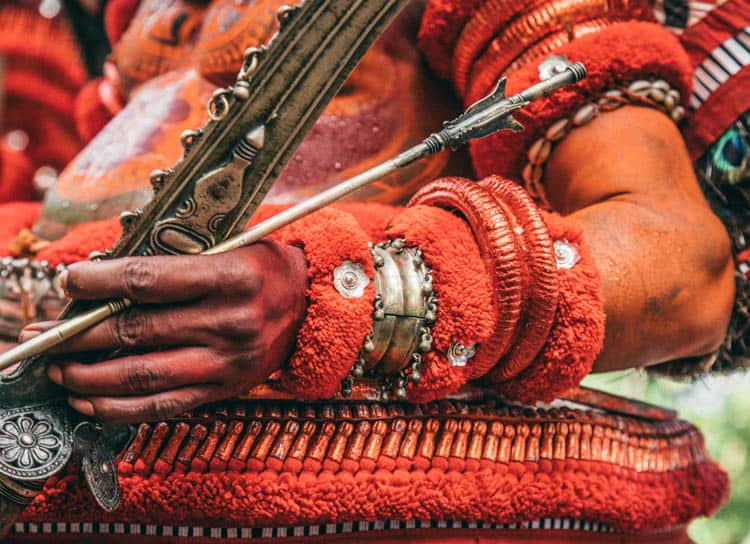
Unforgettable Experience
Santosh assured me that the fire-fueled main events were finished as it approached 5 am. Happy, tired and burnt, we left the temple while smaller performances were to continue way into the morning. Stopping for chai a mile or so down the road we gathered our thoughts after all the hysteria.
Back at the homestay, I was lying in my bed, the morning heat rising, skin covered in ash and sweat and a belly full of sweet chai. It was difficult to get to sleep after all the excitement.
After the busy night turned early morning, you’d have thought that would have been enough. However, there’s something extremely captivating about a Theyyam performance. Subsequently, the next day I attended another ritual, right before jumping on my rollercoaster-like bus ride south towards my next destination.
With my hole-ridden, bonfire-smelling shirt on my back I thought back to the women from the previous night – crying as they asked the Theyyam for their blessings. Spirits may possess the Theyyams during the ceremony, but the Theyyams certainly possess the audience.
I’d only had a glimpse of what it could all mean to them during my brief encounter. I realised I’d probably never experience that level of emotional connection to a performance like this. Furthermore, I’ve taken something away that I won’t be forgetting anytime soon. Certainly, it’s an experience that’s burned into my memory for good…pun intended.
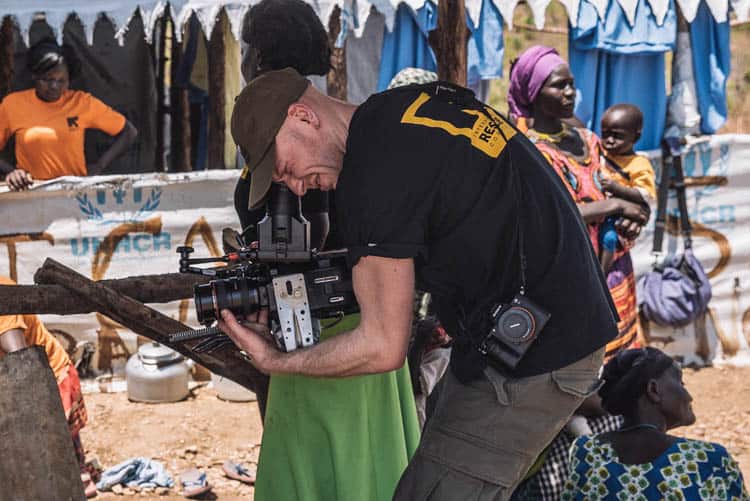
Author Bio: Lee is an award-winning filmmaker and photographer based in London. His work, together with his passion for travel, has taken him to many corners of the globe over the years. He has extensive experience shooting in remote environments across Africa and Asia for charities such as Save the Children, IRC and Book Aid international – the latter recently winning him a Gold EVCOM award for Cinematography.
- Life of a Champion: Exploring the Muhammad Ali Center in Louisville - April 19, 2024
- What It’s Like to Live as an Expat: Lake Chapala, Mexico - April 18, 2024
- Top 5 Spots for Stargazing in North Carolina - April 17, 2024
